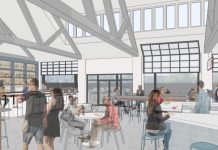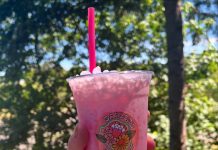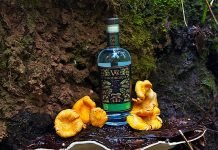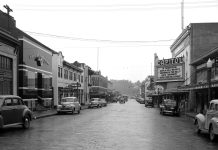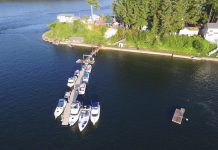By Jake Luplow
 “Throughout the years I have spoken and written about how cancer can personally affect everyone. It affects the rich, the poor, and all nationalities and cultures around the world. About 4 weeks ago I was diagnosed with stomach cancer and I have begun my battle with this disease using chemotherapy,” Gordy Klatt wrote in a recent email to American Cancer Society Staff.
“Throughout the years I have spoken and written about how cancer can personally affect everyone. It affects the rich, the poor, and all nationalities and cultures around the world. About 4 weeks ago I was diagnosed with stomach cancer and I have begun my battle with this disease using chemotherapy,” Gordy Klatt wrote in a recent email to American Cancer Society Staff.
According to the Relay For Life website, relayforlife.org, in May 1985, Dr. Gordy Klatt ran and walked 83 miles at Baker Stadium at the University of Puget Sound in Tacoma. As he circled the track for 24 hours, friends, family, and patients watched and shared in his tremendous effort to raise money for the American Cancer Society. He raised $27,000.
But this wasn’t enough. Gordy envisioned something greater. Something more grandeur. He envisioned a 24-hour relay event, a team effort to raise more money to fight cancer.
Since then, 5,000 communities in the United States and 20 communities in other countries gather yearly to take part in this relay cause.
 In another recent email, Gordy wrote, “I am even more energized to defeat this disease worldwide. I will again be with all of you in spirit this Relay season—even more so this year. Celebrate the survivors; remember those who lost the battle and fight back! We all need to celebrate more birthdays and by relaying we keep the hope alive through education, community involvement and fundraising for ongoing research.”
In another recent email, Gordy wrote, “I am even more energized to defeat this disease worldwide. I will again be with all of you in spirit this Relay season—even more so this year. Celebrate the survivors; remember those who lost the battle and fight back! We all need to celebrate more birthdays and by relaying we keep the hope alive through education, community involvement and fundraising for ongoing research.”
And now, on June 29th 2012, the tradition of hope remains faithful as Relay For Life Thurston County kicks off at Timberline High School.
Beyond the rising sun, lies a dark night falling upon its rays. Beyond the rain trickling upon the meadow, lays snow falling, concealing the life below. And beyond our most honorable intentions, lies the spirit of disease, attempting to dampen our efforts to fight back.
When I first received this assignment, I asked myself, “What is it?” And now, just moments before the event, I am about to witness 24 hours of memorable moments strung together like heart beats, pumping strong, without fail—for cancer never rests and neither do the participants taking a stand against this disease.
And so it begins…
 The opening ceremony, 6 p.m. Hundreds of people stand, gathered around the track at Timberline High School. Their faces glowing like hundreds of phosphorescent beacons.
The opening ceremony, 6 p.m. Hundreds of people stand, gathered around the track at Timberline High School. Their faces glowing like hundreds of phosphorescent beacons.
Supreme Court Justice Mary Fairhurst gets on stage and begins, “It’s my great pleasure to join you here as a survivor. Our theme this year, as every year, is to celebrate, to remember, and to fight back. And we’re here to celebrate you, the survivors, and also to celebrate life. Every day is a gift, and we can decide how we want to spend it; I want to spend today being grateful. None of us know when we’re going to die. But those of us who have cancer have death show up a little bit closer; it makes us stop and pause. But you know, that gives us the opportunity to stop and say thank you, and boy, this really is a beautiful world. I don’t know why cancer came into my life, but there must be something to be learned from it, taken from it, and embraced from it. Life isn’t about how you survive the storm; it’s about how you dance in the rain.”
Silence saturates the air as her words echo into our ears. Who are these faces; who are these people? I think. Some are survivors, some are participants, and some are here in spirit. But all are here to distill hope through a vision to give people more time with their loved ones.
As Shelley Sprouffske, captain of Connolly’s Crew relay team, explained last week, “There’s no greater movement in the world to fight cancer than at Relay For Life—where all survivors are celebrated, those we’ve lost are remembered with honor, and every person has the chance to fight back. In our lifetime, we want to see an end to cancer.”
This year alone, Team Connolly raised $52,375.28—and more than $180,000 over the last five years.
The opening ceremony comes to a close and the survivor lap kicks off. This starting lap is for survivors of the disease and for their caregivers to walk side by side in triumph.
As the survivors round the fourth corner of the track, I can’t help but think how symbolic this really is. When first diagnosed with cancer, they pressed forward down the track of their illness, rounding corners as they fought hard to live, as they fought to be able to give yet another hug to a loved one, or cook yet another meal for their spouse. And finally, when they rounded the last corner on the track of life, when the doctors had given them the good news, that the cancer is dissipating, they could see their finish line, they could see their loved ones—and probably with more clarity than before.
The first lap comes to a close; the teams now begin walking.
According to Dawn Gadwa, Accounting and Registration Chair, during the course of the year, these teams gathered pledges from different people and organizations. The whole idea is that at least one person from each team remains on the field walking for the duration of the event.
Around 6:30 p.m. I sat down with a woman, Tori Fairhurst, and this is what she said:
“On June 26, 1999, just before sunrise, surrounded by all of her children and her husband of 43 years, my sweet Mom died from breast cancer. She was 63. I was 33.
 “My mom received her final cancer diagnosis on her birthday. The cancer had spread all throughout her body. It was everywhere. She died in 5 weeks. She suffered greatly. All 7 of her children and our spouses, all 12 of her grandchildren, and especially my father, were reeling.
“My mom received her final cancer diagnosis on her birthday. The cancer had spread all throughout her body. It was everywhere. She died in 5 weeks. She suffered greatly. All 7 of her children and our spouses, all 12 of her grandchildren, and especially my father, were reeling.
“When my mom took her last breath, I felt like I stopped breathing too. How could this woman who was so central to my life, so absolutely essential to my happiness, be gone? I felt physically sick. Suddenly, the world felt strange and confusing. Like it was in slow motion. Completely surreal.
“Before she died, my mom called all 7 of her children into her room. She was very sick. She looked at each one of us and said, ‘I will never leave you. I will always be with you. You will not be orphaned. I will always be your mother. Our bond is eternal.’
“And it’s true. She is with me. She is with me right now just as much as you are. But it’s not the same. I miss her. I miss her hugs. I miss her laughter. I miss her wisdom. I miss her cooking! And I miss the way that she treasured each one of us. She held our lives, gently. The gift of her love, the memory of her love, blesses me every day of my life.”
Despite this tragic circumstance, Tori decided to fight back in love for her mother, for memories that will never fade. She has been walking at Relay For Life since 2001.
Shortly thereafter in the high school’s cafeteria, the Survivor Dinner starts—sponsored by Dirty Dave’s Pizza. Survivors gather around and share a meal together.
 Terry Thorsell, a 21 year employee at Dirty Dave’s, explained, “We have sponsored this Survivor Dinner for years. It’s completely volunteer run, and all of the money raised goes straight into the event. This dinner means a lot to all of the employees and me at Dirty Dave’s because it’s hard to find someone who hasn’t been affected by cancer one way or the other.
Terry Thorsell, a 21 year employee at Dirty Dave’s, explained, “We have sponsored this Survivor Dinner for years. It’s completely volunteer run, and all of the money raised goes straight into the event. This dinner means a lot to all of the employees and me at Dirty Dave’s because it’s hard to find someone who hasn’t been affected by cancer one way or the other.
The Luminaria Ceremony, 11 p.m. Imagine, in the midst of celebration, everyone gathering in quite attentiveness. Luminaria bags lined around the track—the flats of the bags etched with names of loved ones, some with drawings. Candles placed and lit in each and every one.
Last week, Dawn explained to me, “During the first part of the event, people can submit memorial names to be read at the ceremony.”
I open my backpack and pull out my Luminaria bag, my grandfather’s name written upon the front and a picture of an airplane underneath. I then place my candle in it and position it next to another’s bag.
The ceremony continues in the dark of night. Darkness holds our environment while these bags glow in our peripheral. And each name read brings forth a greater appreciation for life that one can only gain through the remembrance of death.
“The Luminaria Ceremony is a great way to remember those who have passed away and those who are currently battling the disease. This ceremony means a lot to me because my mother passed away from cancer.
“Sometimes, you may even recognize one of the names on someone else’s bag,” Jonathan Sprouffske said.
The ceremony finishes, and things begin to settle down a bit as people retire to their tents to sleep. But the event is far from over.
Teams begin walking again. And though the moment is shadowed by the dream world, activities still go on through the night.
I look up to the sky, to its darkened canvas and rupturing clouds, and think to myself, it is under your watch that we sleep, that we dream. And yet, tonight, we are more alive than ever. Tonight, we are fighting for lives. We are buying back time.
It’s now 6 a.m. It’s another cloudy day in Washington, yet the spirit of summer still shines upon the retina of our minds. The music picks back up, people continue walking, and activities remain constant.
This isn’t just another day. No, it’s much greater: the turning point in life. When darkness falls under and dawn is birthed anew. The point when cancer patients think to themselves: I have fought this long and hard; there is no going back. I must hang in here, and hold on to life.
The day’s events are coming to a close as the closing ceremony begins.
 Dawn steps on stage and says, “To all of you, thank you: you’re one of the top events out there. We are what’s called a mega event. Out of the 500, we place in the top 15 events. So you really deserve to give yourselves a round of applause.
Dawn steps on stage and says, “To all of you, thank you: you’re one of the top events out there. We are what’s called a mega event. Out of the 500, we place in the top 15 events. So you really deserve to give yourselves a round of applause.
“I would like to sum up with a few words from Dr. Gordy Klatt about why we’re here and what we can do together: ‘Relayers raise money, the money funds the research, research kills cancer; therefore, relayers kill cancer.’”
The total amount of money raised this year was $293,017.26. Relay For Life Thurston County was more than just a good cause; it was a cause for life. An event that allowed time to stop—death’s time—so that healing could take place.






